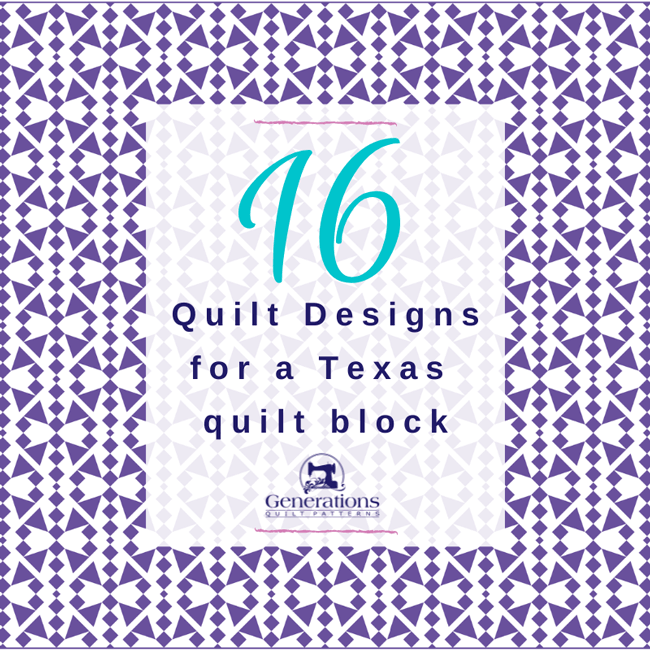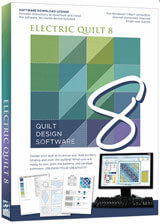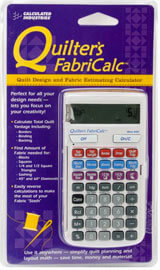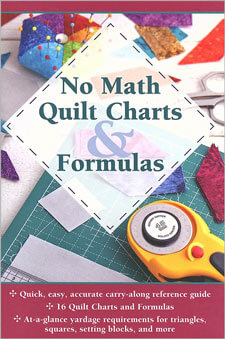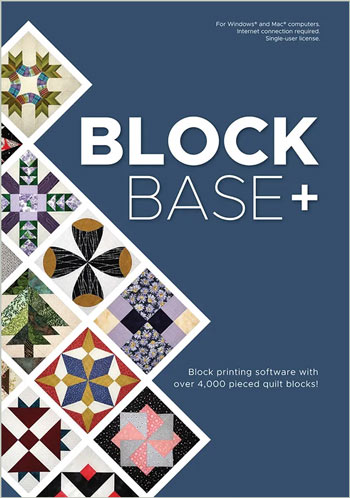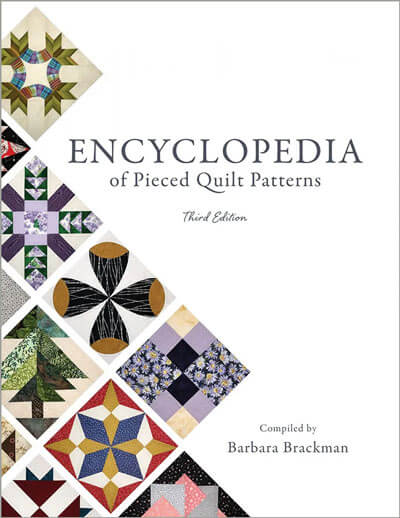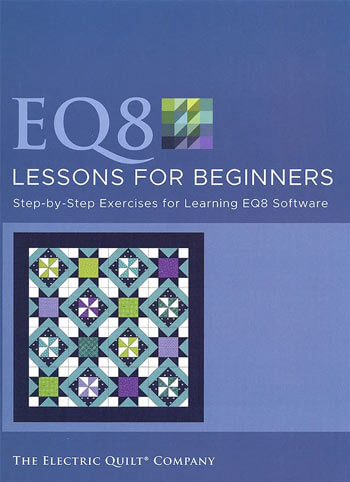- Home
- Quilt Design Inspiration
- Texas Quilt Pattern
Texas Quilt Pattern Inspiration - Design a stunner with the Texas block
This post contains affiliate links, for which I receive compensation.
Howdy, partner! Are you ready to lasso some design inspiration for your next quilting project?
The Texas quilt pattern may look like a simple design at first glance, but don't be fooled—the results are anything but ordinary.
And the best part?
You don't need to be a seasoned pro to create stunning designs—confident beginning quilters can wrangle up some impressive results with this simple yet dynamic block. With just a few easy-to-master piecing techniques, you can create stunning and dynamic quilt designs.
Whether you prefer the clean lines of solids or the wild and woolly charm of scrappy palettes, you'll be cheering "YIppe-Ky-Yay!" in no time.
Sew grab your boots and saddle up.
Let's ride into the sunset with some simple yet stunning quilt designs.
The Texas quilt block
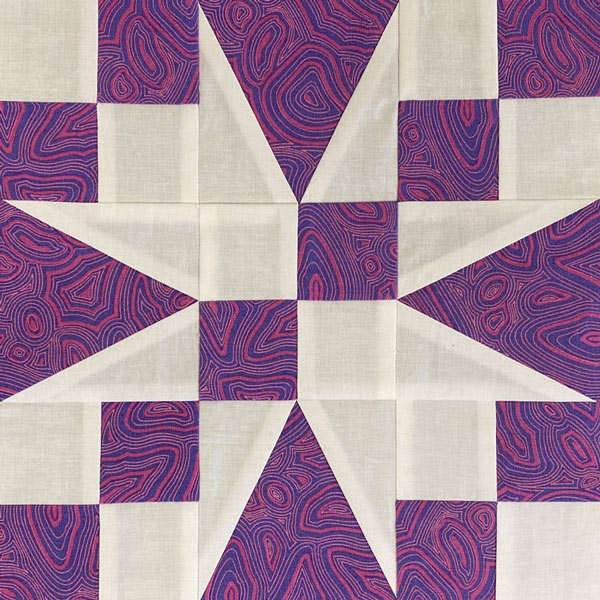 A Texas quilt block ready for a quilt
A Texas quilt block ready for a quiltThe block, itself, has a strong diagonal element, with the dark squares flowing from upper right to lower left.
It's an asymmetrical block, too. There'll be more unique designing opportunities because of it.
On this page are 12 unique design ideas and suggestions for piecing them.
At the bottom of this page, are links to several free goodies for you to print and use:
- Two Texas quilt pattern coloring pages—a straight set and a diagonal set with sashing.
- A printable resource for 'How Many Blocks do I need?'
- A printable worksheet for calculating the size of the quilt to best cover your bed.
How to view these Texas quilt pattern designs
All the design variations are drawn with 5 columns of 6 blocks, unless otherwise noted.
Dark purple 1/4" binding finishes each quilt.
Drafting considerations
As I prepared these images for the web, I removed all the outlines of the blocks and the patches.
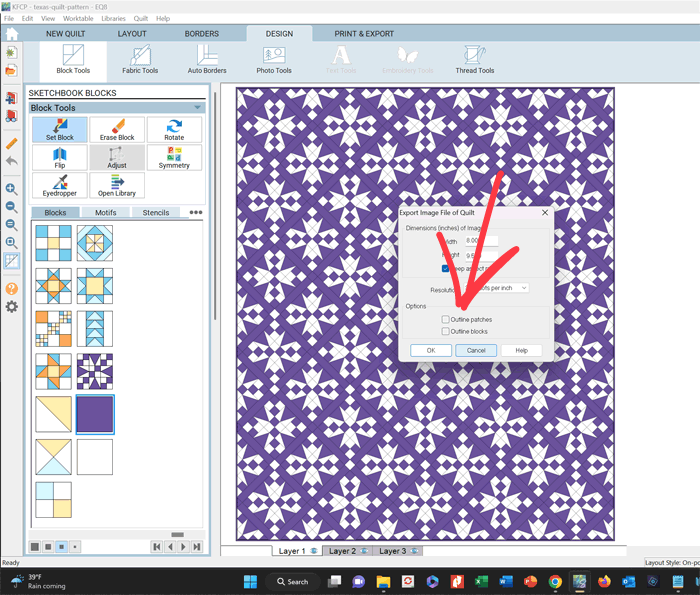 Electric Quilt makes it easy to remove the patch and block outlines with just a couple of mouse clicks
Electric Quilt makes it easy to remove the patch and block outlines with just a couple of mouse clicksNo, I promise I'm not trying to play a dirty trick on you—I am trying to stretch your imagination.
The Texas quilt block is the basis of each design. But that doesn't mean you need to piece that particular quilt using the Texas block.
I've manipulated the block layouts in various ways to come up with patchwork designs. But that doesn't mean an increase in the piecing difficulty. All that's been added are rectangular sashing strips and square cornerstones. The piecing just doesn't get much easier.
I use Electric Quilt 8 software to draft all these designs, and have it for both Mac and PC. It's a fabulous tool if you want to design your own quilts—and so much faster than repeated drafting of the same block.
It's hard to see the forest for the trees, even in Texas!
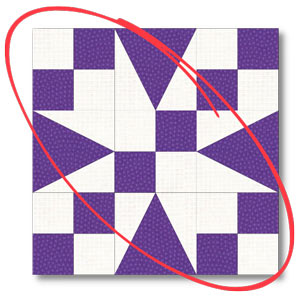 Look for the pair of 'blue bonnets' to find the block if it disappears on you.
Look for the pair of 'blue bonnets' to find the block if it disappears on you.Expect to occasionally have a hard time finding the Texas block.
When that happens, look for the pair of 'blue bonnets' first.
If that fails, look for a strong diagonal line of dark purple squares.
If that doesn't work, look for the sashing and cornerstones in all but the first two designs. The color and size of the sashing/cornerstones in the description underneath each variation.
 You can kind of see where the inspiration for the block came from...
You can kind of see where the inspiration for the block came from...Abbreviations
GU stands for 'grid units'. We drafted the Texas quilt block on a grid (think sheet of graph paper) of 6x6 units in the block tutorial. By changing the size of the GU, we change the size of the block.
If the GU is 1", our 6x6 block is 6" finished. If the GU is 2" it finishes as 12".
GU is always the finished size. The unfinished size is 1/2" larger—length and width—to account for seam allowances.
So if a grid unit (GU) finishes at 2", a sashing strip that is 1 GU wide is 2" wide finished (cut at 2-1/2" wide).
If the sashing is 1/2 GU wide, then it's 1" finished with strips cut at 1-1/2" wide.
S/C stands for sashings and cornerstones. It just saves a lot of typing. ;)
Texas blocks set edge-to-edge
We start with edge-to-edge layouts to see if anything fun happens at the corners.
What do you see?
Without all the lines of the blocks/patches to distract you, it's apparent that you don't need to make a Texas block to make either variation below.
(There's a coloring page for this first design.)
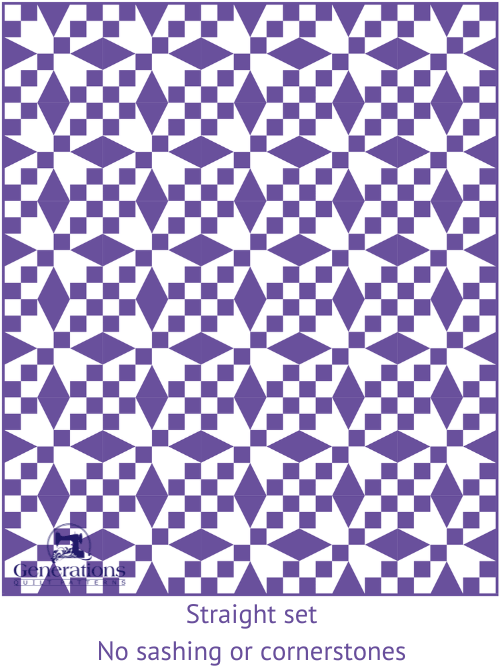
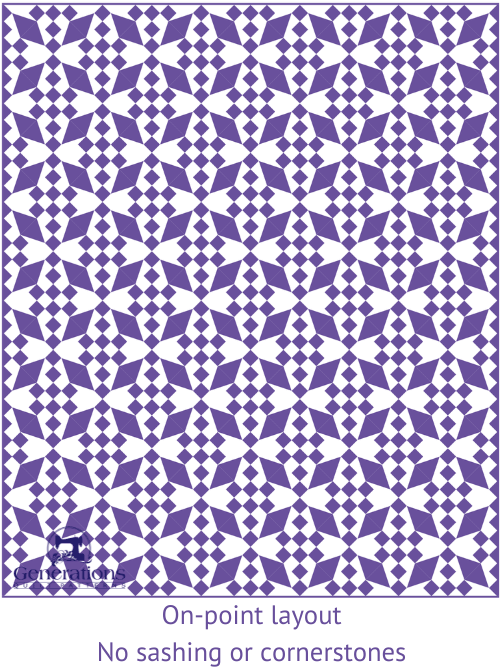
Depending on what and how you like to piece, you may find it more enjoyable to piece these designs with alternating blocks of 4x4 checkerboards of alternating light and dark squares...
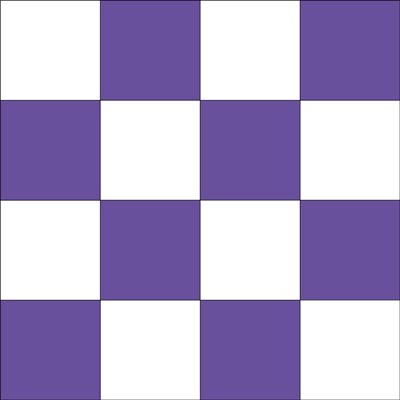 4x4 Checkerboard block
4x4 Checkerboard block...with Diamond in a Rectangle units (like in the Storm at Sea pattern)
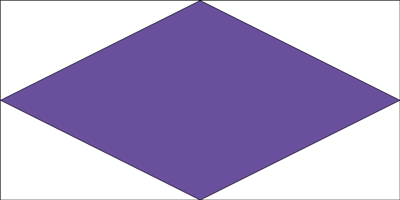 Diamond in a Rectangle block
Diamond in a Rectangle blockNow, some of you might be saying, "Hey, Julie! I don't want to piece those Diamond in a Rectangles? They make me want to vomit in my mouth."
Valid point.
However, if you're comfortable with paper piecing, those units are nothing more than two 'Triangle in a Square' units—except you won't have to seam them together. It's a more efficient way to get to the end result...a FINISHED quilt!
Me?
I'm always up for simplifying the piecing. There are more quilts in my head to piece than hours left in my lifetime. I suspect that's the same for most quilters.
Sew. How would you piece these?
Add sashing and cornerstones
There's a humongous benefit to using sashings and cornerstones between your blocks.
First, there's no need to fiddle around with the pressing directions to get your outside-edge seams to nest.
 White sashing with a purple cornerstone
White sashing with a purple cornerstone Purple sashing with a white cornerstone
Purple sashing with a white cornerstoneOr worse, having seams to match where the seam allowances are both pressed in the same direction. That just makes for lumpy quilts.
Not to mention, the machine quilting is harder, too.
Who wants to run into a bulky lump unexpectedly with your needle?
"Me! Me! Me!" said no Quilter EVER.
In these next two pattern variations, there's a narrow sashing/cornerstone (S/C) between each Texas block. (It's 1/2 a grid unit, like we discussed above).
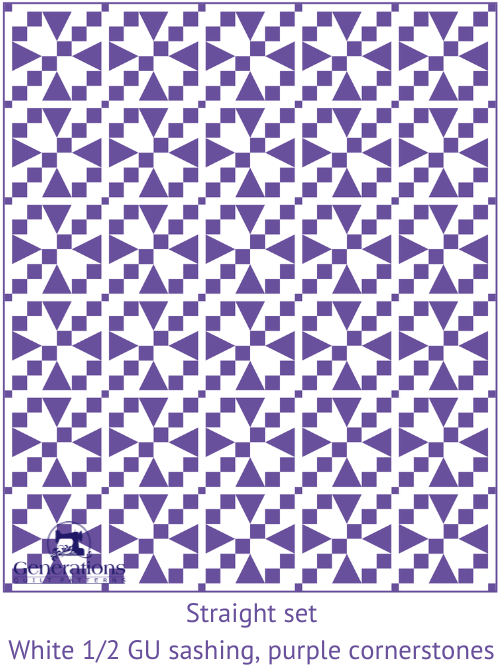
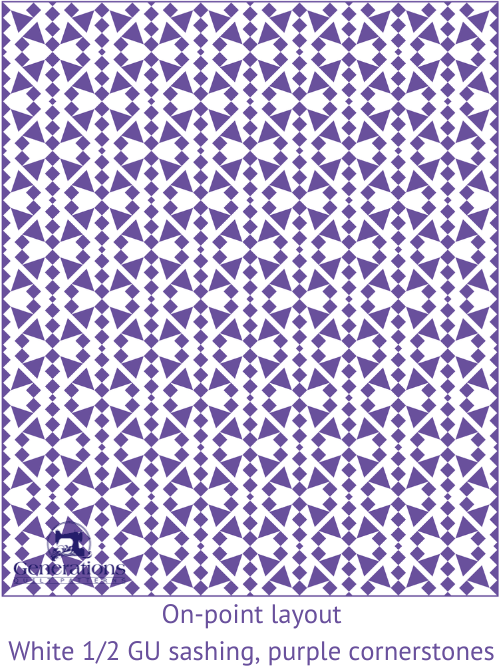
The straight set is nice. But just 'nice'.
The diagonal setting is dynamic. One of those where you have to search for the Texas block, right? (Tilt your head 45° and look for the narrow white sashing between the blocks.)
The rows of triangles at the sides of the quilt are an unexpected charming touch.
Next up, the only changes are increasing the width of the sashing to 1 GU and then swapping the S/C colors.
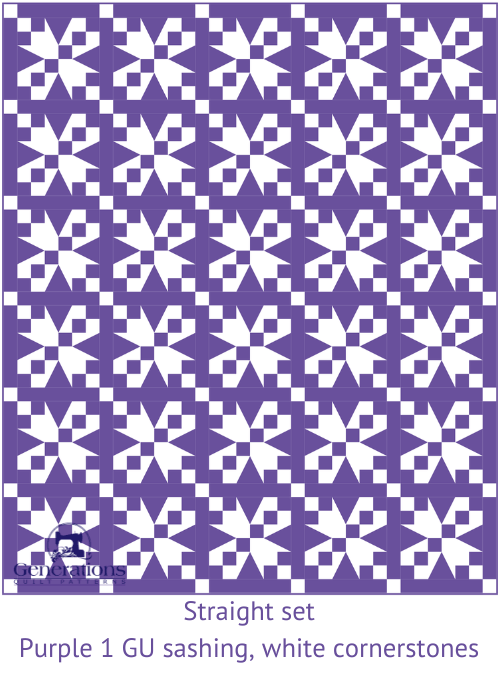
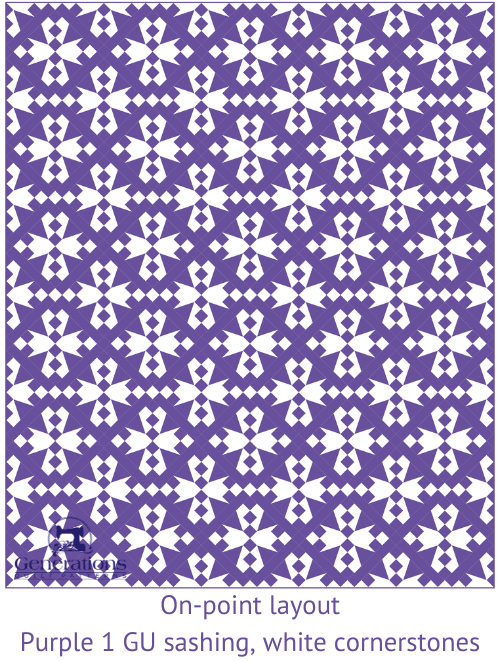
Add a quarter turn to some alternate blocks
Next up are the two versions of the straight setting with a smaller 1/2 GU wide S/C. To add a little interest, alternate blocks are rotated a 1/4 turn.
It's remarkable just how different these two look with such simple changes.
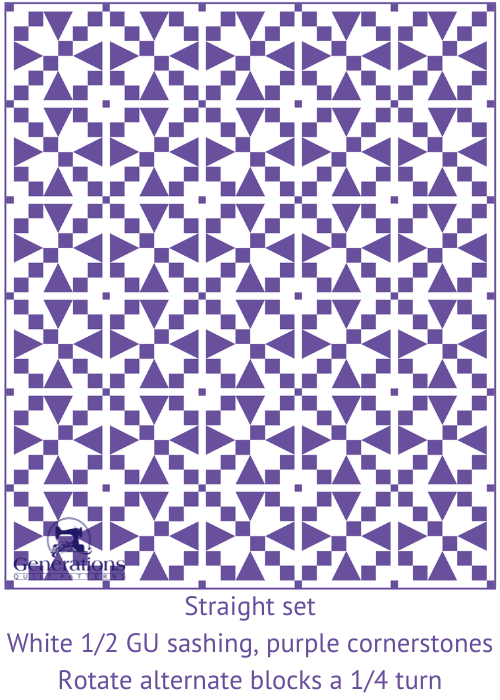
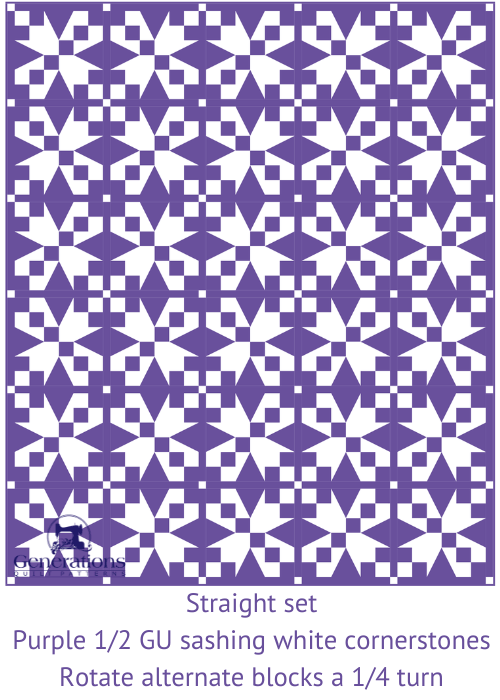
After rotating the alternate blocks, look for that strong purple diagonal to find the Texas block if it disappears on you.
It's a nice effect on the straight set. That circular optical illusion is floating in and out as you look at the design. It's almost like there's a white line appearing around patches.
Do you see it, too?
Weird how our eyes play with the illusion, right?
Here the S/C are 1GU and the Texas block appears again, easy to spot.
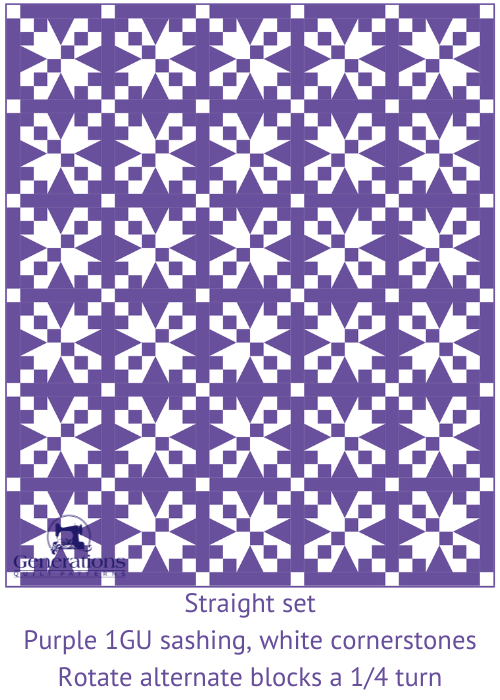
Back to an on-point layout, now we rotate the Texas blocks a 1/4 turn every other row moving down from the top.
The circular illusion still floats in and out. And if you stare at it for a while, the little plus signs (with the white corners) appear to bulge out slightly.
Our eyes are a remarkable thing.
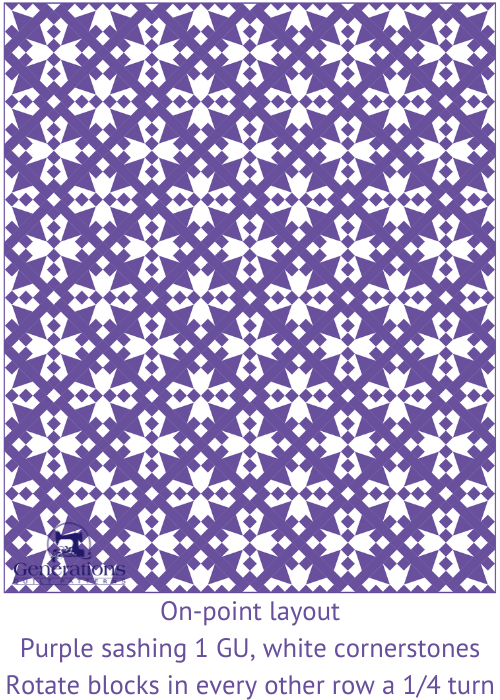
Simply exchanging colors in the sashings and cornerstone squares and we have:
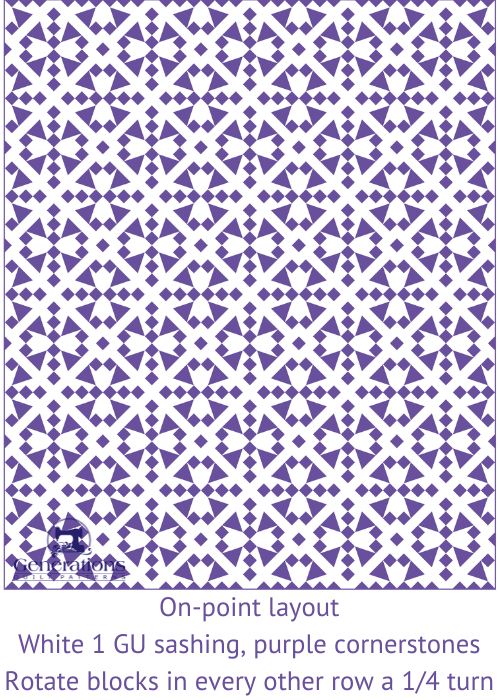
I love how the squares form a gird.
Next we'll go a bit crazy with rotating blocks in this on-point layout with 1GU sashing in white and purple cornstones.
In the first full row, the tulips are alternating starting with East-West, then North-South.
Second row—the one where the squares create a line clear across the width of the quilt top—they are all North-South.
Third Row, they start North-South, then East-West.
Your eyes WILL go a bit dizzy, but the resulting graphic design is worth it!
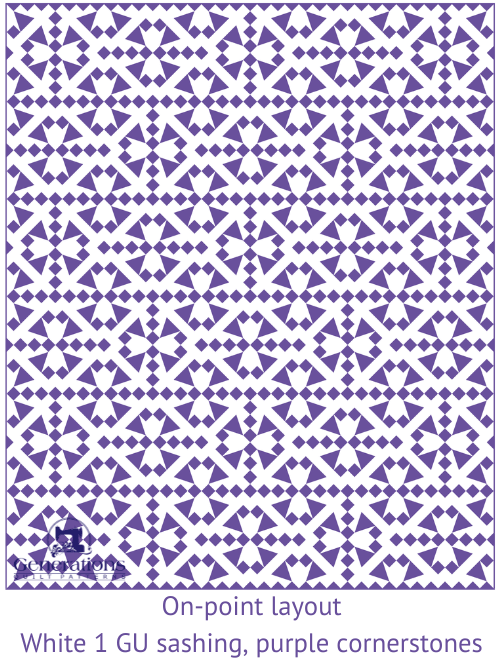
Now that we've found something that looks way more complicated than it really is, let's try one more design trick.
Add solid squares for a machine quilting playground
What happens when we remove some blocks (i.e., make it easier to piece because there's less of it) and replace them with solid squares and setting triangles?
The design is almost 'lacy' looking.
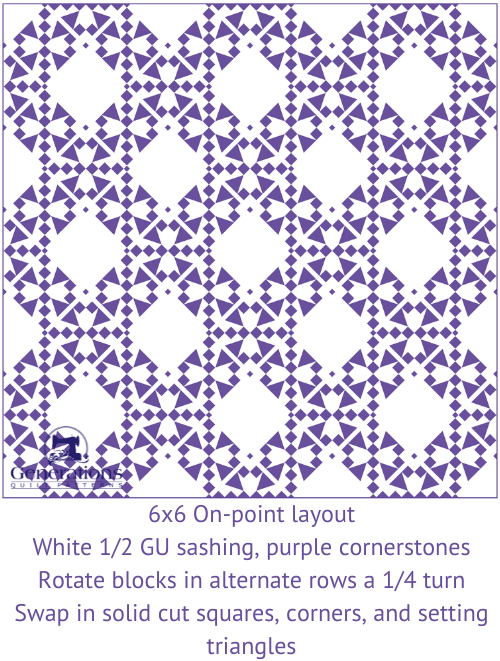
It's the ideal place for you or your machine quilter to have some fun.
Remember, that to make the design symmetrical, we need even numbers of Texas quilt blocks in the rows and columns.
Let's take another stab at this same idea.
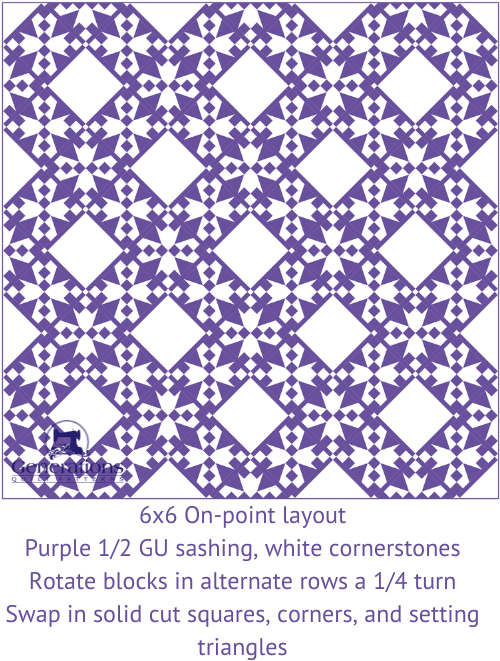
One final, teensy change. Instead of 1/2 GU for the S/C, let's change it to 1 GU.
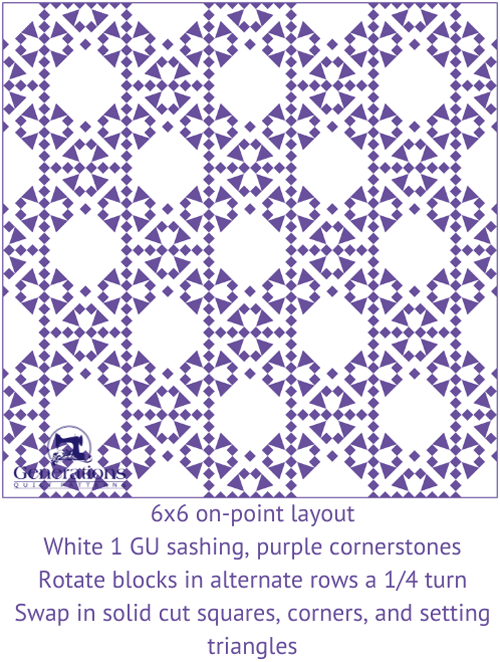
The wider sashings would be helpful if you needed to fit a quilting design to the open spaces.
These simple Texas quilt pattern designs will have you saying 'YEE-HAW!'
Get ready to surrender yourself to the rhythm of your sewing machine and create spectacular designs with minimal effort.
There's nothing like loads of simple piecing, and letting the fabric do a lot of the work when you have the urge to sew.
No lengthy sessions at the cutting mat either for these.
Just the mesmerizing hum of your sewing machine and designs that look oh-so intricate!
Will you try your hand at a quilt design using the Texas quilt block pattern?
[Click here to learn how to make the Texas quilt block. in 3 sizes.]
As promised, a few free resources for you!
Tools to make quilt designing easier...
Click any image for more information, reviews, and pricing.
- Home
- Quilt Design Inspiration
- Texas Quilt Pattern
